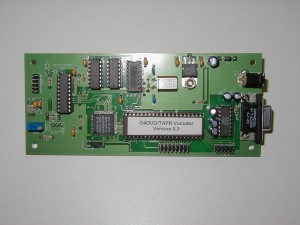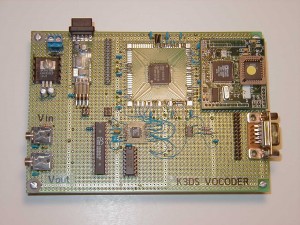The Digital Voice Project (DVP) is a effort by Amateur Radio experimenters to progress beyond analog modulation for voice communication. Amplitude modulation (AM) was devised in the 1920s, frequency modulation (FM) in the 1930s, and single sideband (SSB), actually pioneered by Amateur Radio experimenters, also in the 1930s. AM, FM and SSB modulation as used today are all virtually unchanged since their inception. Amateur Radio does utilize a variety of digital modes, including radioteletype (RTTY) using frequency shift keying (FSK) devised in 1930s with electromechanical teleprinters, and even the newest bandwidth efficient digital modes, such as PSK31, which employ personal computers (PCs) and the sound card interface.
The original experiments in digital voice were presented by Charles Brain G4GUO and Andy Talbot G4JNT. Here the various versions of the next generation of digital voice hardware, consisting of a voice coder (vocoder) and modem, were presented.
The original vocoder was the Digital Voice Systems Inc (DVSI) AMBE-1000, based on the Lucent DSP16 processor. Advanced Multiband Excited Coding (AMBE®) is a speech compression algorithm that can reduce the nominal bit rate of sampled and quantized communication quality speech (8 bit mu-Law samples at 8 KHz sampling rate or 64 Kb/sec) to lower the resulting transmission bandwidth (from >=64 KHz) to approximately 3 KHz.
A vocoder board using the AMBE-1000, a PIC microprocessor host, a Motorola MC14LC5480 8 bit, parallel input mu-Law codec (analog-to-digital and digital-to-analog converter) and digital logic was first demonstrated at the TAPR/ARRL Digital Communications Conference 1999 in Phoenix. The original 64 Kb/sec speed sampled voice signal was compressed by the AMBE-1000 device to 2400 b/sec with 1200 b/sec of Forward Error Correction (FEC) for a transmit data rate of 3600 b/sec.
A suitable replacement for the AMBE-1000 is the half-duplex AMBE-2020 device (a fully pin compatible full-duplex device is the AMBE-2000), based on the Texas Instruments TMS320C54xx processor. The new vocoder architecture then is the DVSI AMBE-2020, an Analog Devices AD73311 16-bit codec and the Ubicom SX28 microprocessor. Although the PIC is a popular microprocessor for Amateur Radio projects, the Ubicom devices are more than comparable, high speed (to 100 MHz clock frequency) and feature low cost development tools from Parallax. However, to extend the development to a variety of host platforms, the DVP provided a complete description of the data protocol for the AMBE-2020 so that experimenters could implement other microprocessors or direct connection to the PC bus.
microprocessor for Amateur Radio projects, the Ubicom devices are more than comparable, high speed (to 100 MHz clock frequency) and feature low cost development tools from Parallax. However, to extend the development to a variety of host platforms, the DVP provided a complete description of the data protocol for the AMBE-2020 so that experimenters could implement other microprocessors or direct connection to the PC bus.
The prototype AMBE-2020 vocoder was a 2002-2003 ECE Senior Design Project with team members Yazime Allen, Melinda Gleiter, and Jodi Moore. The AMBE-2020 vocoder was extended and the technical details were presented the ARRL/TAPR 2003 Digital Communication Conference. The original modem as designed by Charles Brain G4GUO was a 36 tone BPSK modem with a 20 msec symbol duration, with tones spaced every 62.5 Hz from 312.5 to 2500 Hz. The AMBE-1000 vocoder and modem were used in successful digital voice experiments on the 40 meter amateur radio band by over a 70 km path from the G4GUO to the G4JNT stations. The DVP AMBE-2020 vocoder features a ‘modem port’ using high-speed serial data transfer and a standard protocol. The DSPx ADSP-2185 DSP microcomputer from Lyle Johnson KK7P has been interfaced to the vocoder to become the modem.